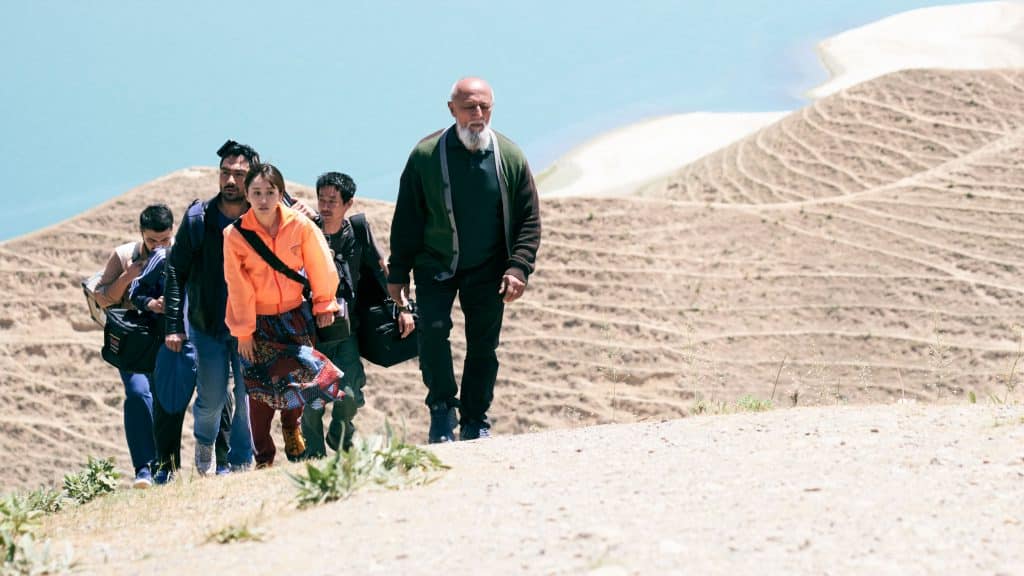Read also:
How to Watch FX Live Without CableHow To Watch AMC Without CableHow to Watch ABC Without CableHow to Watch Paramount Network Without CableKiyoshi Kurosawa’s state-sanctioned drama elevates itself beyond its cultural mandate to explore more universal notes to the human condition.
Kiyoshi Kurosawa’s To the Ends of the Earth follows Yoko (Atsuko Maeda), a young Japanese woman reporter who is in Uzbekistan filming an expose of the country’s culture for a travel show. She starts off with a smile, but soon after the discrepancies of Uzbek and Japanese culture becoming a hindrance that soon seeps deeper into mental fatigue.
What’s striking about the film is the ways Kurosawa acutely radiates the feelings of tension, fear, and exhaustion of being in a foreign country out of obligation. We all like to think of ourselves as having the ability to adapt wherever we go, especially if it’s for a job, but having to traverse a foreign nation that doesn’t speak your language, doesn’t have your customs, and doesn’t follow the structural and political rules as yours is more than simply a physical adaptation, it requires a total recalibration of one’s mentality.
The details of cultural differences are expertly observed and range from awkward to downright disturbing. The language barrier is, of course, one of the biggest and most obvious obstacles, but the most uncomfortable scene involves clothing. During Yoko’s trek down a market street in short jean shorts, every single person turns to look at her, men darting invasive stares at her exposed legs. She starts to hurry her pace, feeling self-conscious the rest of her day.
Kurosawa accentuates the tension and growing worry of Yoko by concentrating not only on her worried expressions but the way she walks and moves her limbs. Kurosawa understands the way emotion manifests in the physical which is where he concentrates, accentuated in Maeda’s dedicated performance. Through her movements and mannerisms, she elicits a deeply felt sensation of obligation to be in a country she feels so alone in, and being forced to process all of it at once.

Yoko’s unfair treatment as a woman is an undercurrent in the film, sandwiched by men from both sides of the cultural divide. The Uzbek men, much more conservative and traditionalist in their views of women, treat her as a child. They say she’s too weak to ride on a rollercoaster and project their own superstitions about women onto her — in one scene, a fisherman tells her that “fish hate the scent of a woman.” Her Japanese compatriots show a more liberal disregard, filled with casual misogyny and an uncaring attitude for her well-being. This suggests a cynical, devastating idea that bigotry can be a universal language.
Kurosawa’s not so disenchanted as to make this the crux of the movie. This is, after all, a film sanctioned by both the Japanese and Uzbek governments to commemorate the two nations’ diplomacy. In effect, there must be a greater, more positive lesson learned here. That lesson is through Yoko’s fear. Some of it, taken from her encounters with a group of men in damp alleyways who stare at her, is justified.
But other times, where her inability to speak the language leaves plenty of room for miscommunication. A diplomat asks her, “Are we so frightening to you?” Kurosawa toes the line between xenophobia and human instinct, where fear is a natural and common human impulse one that can and should be attempted to overcome.
While Kurosawa strays away from layered plot elements and stylish frames that fill his repertoire for a more straightforward visual look, To the Ends of the Earth is still innately complex. It’s just that his complexity is reserved purely for the character of Yoko, whose life in the streets and fields of Uzbekistan and in the hotel she temporarily stays in embodies the monotonous and lost feeling of work-travel.
Kurosawa strives for the natural and universal.
She has text conversations with her boyfriend from back home, the one form of human connection she experiences throughout the movie. It’s the thread that keeps the isolation somewhat bearable. Yet, at some point, one needs to succumb to the reality of the new place they are in and embrace what happiness can be found. Yoko is asked “how much do you know about us? If we don’t talk to each other, we can’t get to know each other.”
It’s little things that make the authenticity of Kurosawa’s portrayal of a ‘fish out of water’ so relatable. Yoko finds things in Uzbekistan that make her feel connected like a goat that lets her pet him, a rice and beef dish (traditional Uzbek plov) that reminds her of “elaborate fried rice”, or a familiar brand of biscuits she finds in a grocery store.
Art, an expected subject for a filmmaker to draw a case of universality for, is given proper spotlight in the film’s most beautiful sequence: Yoko closes her eyes and perks up her ear as she hears the faint voice of a woman singing. The camera cuts to her entering and traversing the historic Alisher Navoï Opera house in Tashkent. Music seems to be a place of tranquility for Yoko, as Kurosawa’s sequence makes it seem like she is drawn to it instinctively.
Kurosawa uses a montage with tracking shots of Yoko walking down several different corridors each with their own glorious design and color combination. This is both a virtual museum tour of one of Uzbekistans’ historic buildings as well as a visually stunning sequence where Yoko seems to have slipped into another time and place from the frenzy and discomfort of her city experience. The slow camera tracking shots of her gives the feeling that we are watching someone being drawn towards a place of warmth and comfort, like on a stairway towards heaven.

Finally, Yoko walks into the theater where a woman belts out a glorious aria as orchestra members in the pit ready their instruments to play. Suddenly, it’s Yoko who starts singing a Japanese ballad at center stage in a dream sequence – it’s a synthesis of cultures speaking their own languages with music and emotion bridging them.
This is the universal language that Yoko was seeking, what Kurosawa presents as an offering of camaraderie between the two nations. It also provides for an interlude breaking the narrative structure of the film and throwing us into Yoko’s mind. She wants to love Uzbekistan and she offers them a piece of herself and her culture.
That To the Ends of the Earth is a state-sanctioned attempt at commemorating diplomacy makes its artistry that much more impressive. Usually, when there’s heavy government involvement in the content of a film, or (even more worrisome) a political goal to be achieved from its creation, it tends to deliberately and manipulatively pull certain emotional levers. Kurosawa strives for the natural and universal. The result is a movie about how cultures so different from one another, seemingly from different planets, share a commonality – in food, art, empathy – on our pale blue dot.